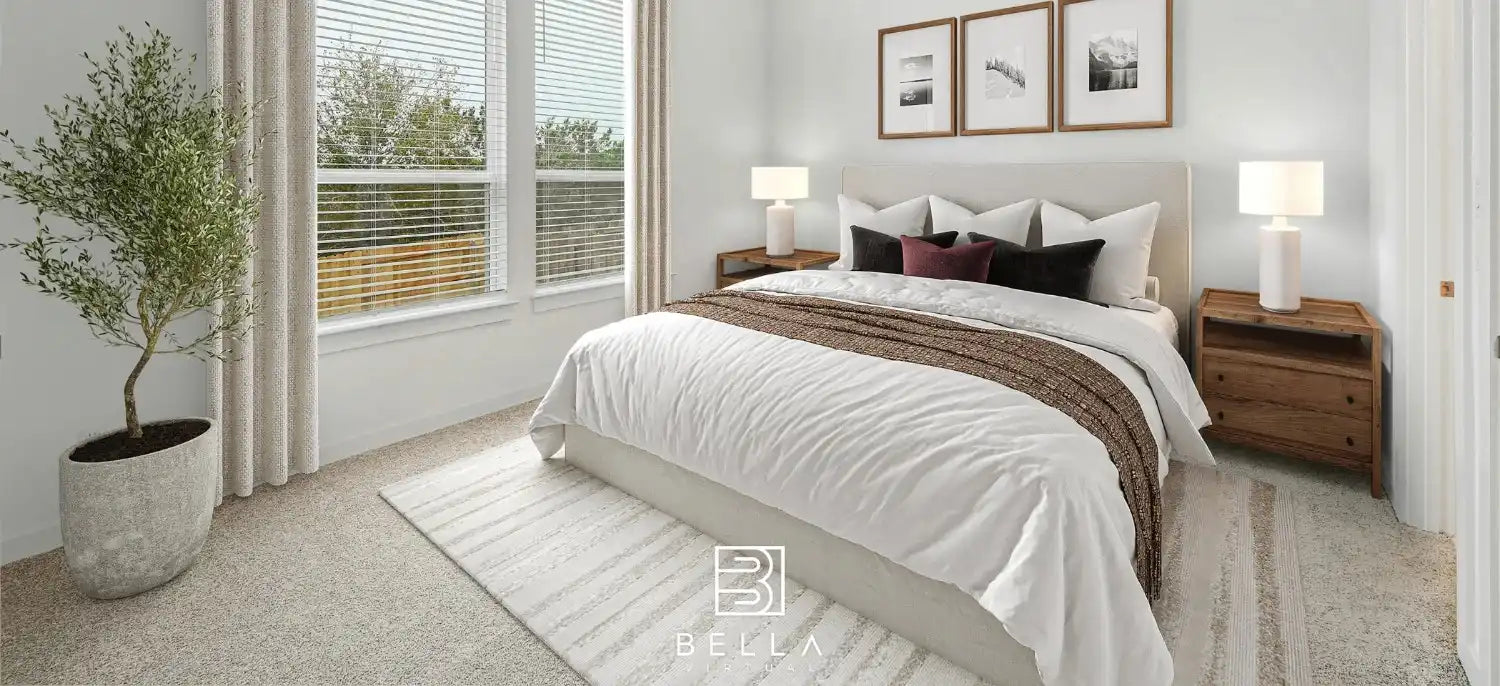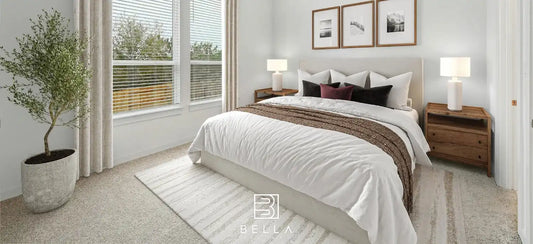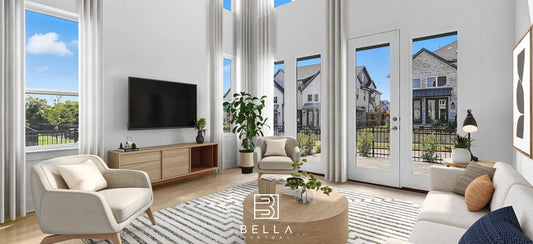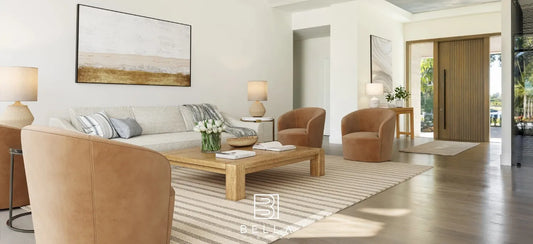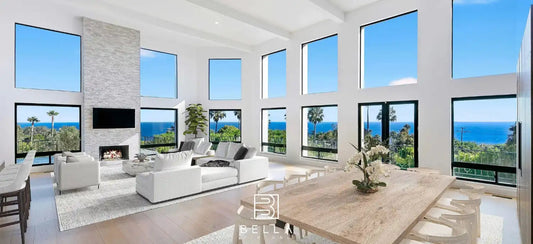This article shows how bedroom staging before and after turns plain rooms into persuasive listing assets that lift engagement and confidence. You will learn the steps, the photography choices that build credibility, and who to hire for results. We also explain how Bella Staging helps you move quickly without overspending or sacrificing quality on market-ready images.
Highlights
- Clear definition: Visual transformations clarify value and reduce buyer hesitation.
- Actionable steps: Small fixes and layout rules drive outsized bedroom ROI.
- Photo credibility: Consistent angles and daylight timing prove authentic results.
What Is Bedroom Staging?
Bedroom staging is the intentional preparation and presentation of a bedroom to make it photograph, show, and sell better. It focuses on layout, scale, lighting, and simple cosmetic upgrades that highlight comfort and usable space. Done well, it helps buyers imagine daily life in the room and supports stronger pricing conversations with sellers.


Staging clarifies how furniture should sit, where light should fall, and which features deserve attention. In practice, it replaces visual noise with a calm, cohesive look that feels move-in ready. By aligning style with likely buyer tastes and comparable properties, it shortens decision time and encourages confident offers.
- Clear comparison: Side-by-side frames reveal layout and lighting changes.
- Credible change: Matched angles keep results honest and persuasive.
- Price support: Visual proof strengthens list-price justification.
See more: 10 Best Tips for Staging a Kitchen to Sell Your Home Faster
Primary Bedroom Staging Before and After, Step by Step
Declutter and Repair for Primary Bedroom Staging
Use this section to reset surfaces, fix distractions, and create pathways that read cleanly in photos. A tidy baseline makes the contrast pop in the “after” shots. Focus on closets, nightstands, outlets, and hardware so the room feels maintained rather than tired—this builds trust during tours and in galleries. Simple, low-cost fixes often beat bigger projects because they change how a room reads online. As the Iowa State study finds that Zillow listings with more photos and richer, experiential descriptions are associated with higher sale prices especially for homes priced well above or below their neighborhood average, investing in what the camera sees is an efficient way to earn attention and value.
- Surface simplicity: One statement item per surface for clean lines.
- Storage signals: Organized closets hint at real, usable space.
- Quiet repairs: Patch, tighten, and align to remove visual noise.
Paint, Textiles, and Lighting Before and After Photos
This part explains how a cohesive palette, layered bedding, and warm lamp light create calm, hotel-like images. Choose light warm-grays or creamy off-whites, carry color over walls and ceilings, then add texture through duvets, throws, and pillows. Balanced lamps at 2700–3000K soften shadows and unify mixed daylight.
Because buyers scan photos quickly, consistent color improves comprehension. Many agents cite staging as a factor in buyer perception, and neutral, well lit bedrooms are often favored in survey data that tracks room importance and impact on offers.
- Color continuity: One neutral family unifies mixed finishes.
- Textile depth: Texture adds interest without busy patterns.
- Lamp parity: Matching pairs create symmetrical focus.
Bed Wall, Symmetry, and Traffic Flow for ROI
Positioning is the most affordable lever to make a room feel larger. Use 3D rendering services to preview headboard centering on the longest clean wall, balance equal nightstands, and confirm 24–36 centimeters of side clearance before you lift a finger. Then right-size the rug so the bed sits partly on the pile, which grounds the scene for both camera and visitors.


These decisions improve how photos read at thumbnail size, which is critical for gallery click-through. Consistent composition and clear pathways make your bedroom staging before and after pairs scannable, and they help the “after” feel aspirational, not overly styled.
- Centered anchor: Stable bed wall calms the composition.
- Clear aisles: Side paths communicate comfort and access.
- Scaled rug: Proper dimensions widen the perceived envelope.
Bedroom Before and After Photos, Framing and Credibility
Angle, Height, and Lens Choices for Consistent Results
Lock a primary corner, keep the tripod around chest height, and match focal length for both the before and the after. This avoids perspective distortion, maintains consistency, and keeps attention on real changes in layout, light, and texture.
If exposure or white balance drift between frames, viewers question the comparison. As Nikon notes, white balance adjusts colors so scenes look natural, and you can set it in camera or fine-tune it in post to keep your before and after pairing honest.
- Repeatable setup: Same spot, height, and focal length.
- Corner anchor: Diagonals add depth without stretching space.
- Line discipline: Keep verticals straight to reduce distraction.
Daylight Timing and Color Accuracy in Bedroom Images
Shoot when natural light is soft, often morning or late afternoon. Turn on lamps for warmth, then balance color to remove blue or orange casts. Avoid heavy HDR that flattens texture. Gentle global adjustments keep the result believable and make your bedroom staging before and after pairs feel consistent across screens.


Because buyers form opinions quickly, coherent color makes it easier to compare frames. A basic calibration routine, even with simple tools, helps you maintain skin-tone realism and wood-tone accuracy while preserving crisp whites in bedding and trim.
- Soft window light: Diffusion flatters textiles and paint.
- Balanced temperature: Neutral color keeps details natural.
- Gentle edits: Non-destructive tweaks preserve realism.
File Prep for MLS and Mobile-First Galleries
Export high-resolution files with crop-safe compositions that survive portal thumbnails. Use descriptive filenames and alt text that reflect the scene for accessibility. Avoid heavy compression that introduces banding in soft gradients, and review the set on a phone since most shoppers browse on mobile first. For consistency and SEO, follow a simple rule of thumb for alt text length, keep alt text under 125 characters and focus on the key features of the image, which helps agents standardize captions and tags across galleries.
- Crop aware: Protect edges from automated thumbnail trims.
- Descriptive names: Clear labels and alt text aid search.
- Mobile checks: Verify clarity on small screens before launch.
Who to Hire for Bedroom Staging Before and After
Bella Staging
Start with Bella Staging to follow a fast, repeatable workflow that uses style boards, a structured brief, and two rounds of revisions. Files arrive MLS-ready with color-accurate output and crop-safe compositions, so your bedroom staging before and after narrative stays consistent across platforms.
For rapid turnarounds, begin in virtual staging by submitting photos and a short brief, which streamlines proofs and keeps costs predictable. Dedicated project managers then coordinate feedback, maintain aesthetic consistency across multiple bedrooms, and align looks with local comps to support pricing conversations.
- Faster to market: Brief today, proofs tomorrow in most cases.
- Consistent look: Portfolio coherence builds agent brand equity.
- Conversion focus: Images optimized for thumbnails and mobile.
Local Physical Stagers and Rental Vendors
Full installs are ideal when tactile experience matters or for flagship properties, and insights from real estate stagers can help you plan inventory, delivery windows, and styling so each room photographs at its best. Capture your before images a day prior and your after images right after install to maximize contrast. Treat the shoot like a launch so the transformation reads cleanly online and in person.
If you later adjust layout, reshoot from the same angle so the comparison remains truthful. Consistent camera height and focal length protect credibility, which is essential when buyers scroll fast and decide whether to click through the rest of the gallery
- Tactile impact: Real materials impress during showings.
- Logistics plan: Delivery windows affect timelines and costs.
- Photo discipline: Pre-plan angles before movers place pieces.
Real Estate Photographers and Hybrid Workflows
Hybrid plans blend light physical styling with targeted virtual enhancements. For rooms where bulky items distract or scale feels off, use Bella Staging’s virtual furniture removal to digitally clear or replace pieces while preserving proportion, sightlines, and a realistic path to a Vacant look. Agree on a short shot list, decide what will be changed virtually, and keep clear records for compliance. Disclose all virtual edits, follow local MLS rules to avoid confusion or takedowns, and maintain consistent camera angles across every version.
Strong photo sets correlate with faster sales when experience attributes are present, which supports using a planned sequence of frames and captions rather than ad-hoc uploads. A well cited industry study discusses how richer listing attributes influence sale prices and buyer decisions.
- Shared plan: Align roles, edits, and delivery dates.
- Clear disclosure: Label virtual changes for compliance.
- Angle integrity: Match camera positions across versions.
FAQs: Bedroom Staging Before and After
1. How much does bedroom staging before and after typically cost?
Costs vary by scope and market. Virtual options are usually lower than full installs and scale quickly when multiple bedrooms need work. Physical staging adds rentals, delivery, and labor, so plan for higher totals. Photography should be budgeted separately because images determine how the transformation reads online.
A practical approach is to pilot one bedroom, then measure impact. Track days on market, saves, and gallery dwell time after updating photos. If engagement lifts, roll the method across primary, guest, and flex bedrooms. Keep disclosures clear if you shift from virtual to physical elements mid-listing.
2. Do I need to repaint, or can styling alone deliver strong after photos?
Fresh paint in a cohesive neutral often gives the best return when walls show wear. However, textiles and lighting can carry the lift if surfaces are already clean. Aim for soft contrast that photographs well and supports a calm, hotel-like mood in the primary suite for both web and in-person viewing.
To decide, start with patching and spot-priming, then paint a single unifying neutral if time allows. Add crisp bedding and balanced lamp pairs. If repainting is impossible, use solid bedding, simple window treatments, and warm bulbs to smooth color casts that can make images look dingy or cold.
3. What colors work best for bedroom staging before and after photos?
Choose warm off-whites, light grays, or pale taupes with gentle contrast. Limit bold accents to small, repeatable touches like a throw or pillow pair. This keeps wood and floor tones from skewing too yellow or red and helps whites stay crisp under mixed daylight and lamp light in photos.
If the look feels flat, add texture rather than saturation. Linen, bouclé, and knitted throws photograph with depth without visual noise. Keep art simple and at the proper height. Balance color in camera or post so your bedroom staging before and after series remains believable across devices.
4. How do I stage a very small bedroom for better before and after impact?
Right-size the bed and use a slim headboard to open floor edges. Choose petite nightstands, keep pathways clear, and place a single art piece above the headboard. A properly sized rug frames the bed and reduces visual clutter, which reads as more generous space in photos.
Work from the camera’s primary angle. Place the tripod first, then set the bed and lamps to read cleanly from that position. Avoid ultra-wide lenses that exaggerate corners. Keep cords tidy and doors fully open or fully closed to reduce distractions in both frames.
5. Can virtual bedroom staging replace physical staging for bedrooms?
Both methods have a role. Virtual staging is ideal when time or budget is tight, or when rooms are vacant and you need marketable images quickly. Physical staging adds tactile experience for showings. Many agents launch with virtual assets, then add select props later for in-person impact.
Follow MLS rules and label images with virtual edits to avoid confusion. Keep angles identical across the before, virtual after, and any later physical after. When edits are modest and disclosed, viewers focus on true layout and lighting improvements rather than doubting the comparison.
See more: Step-by-Step Checklist for Staging Restaurants That Work
Conclusion
Transformations shown through bedroom staging before and after help sellers price confidently, reduce days on market, and build buyer trust. If you want a fast, consistent pipeline, Bella Staging can turn a short brief into MLS-ready images that align with comps and read cleanly on mobile. For next steps, contact us to scope your rooms and schedule delivery.






